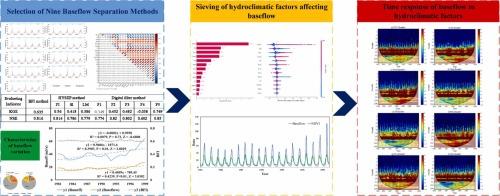西北内陆河流域基流变化原因分析
IF 5
2区 地球科学
Q1 WATER RESOURCES
引用次数: 0
摘要
研究区研究区为中国西北内陆河流域,玛纳斯河上游流域。研究重点基流是干旱地区旱季水资源管理的重要组成部分。基流的形成机制受流域特征(面积和地形)和产流过程(降雨与融雪优势)等多种因素的制约。为探讨玛纳斯河流域基流动态的驱动因素,采用多源遥感数据确定了最优基流分离方法。此外,通过可解释的机器学习方法,特别是分类促进(CatBoost)和SHapley加性解释(SHAP)分析,定量评估了水文气候变量和植被条件对基流的影响。结果表明,Eckhardt滤波方法为流域基流分离的比较评价提供了最佳性能。分析结果表明,归一化植被指数(NDVI)、雪深(SD)、降水(Prec)、地表气温(Temp)、太阳辐射(SR)、剖面土壤湿度(PSM)和积雪面积(SCA)等水文气候变量对基流动态有显著影响。其中,NDVI表现出特别显著的影响。这些因素共同导致基流形成过程延迟大约两周。定量分析显示,SD的延迟时间最短(12.45 ± 8.50 d),而SR(14.16 ± 6.67 d)和Temp(14.89 ± 7.58 d)的延迟时间相当。值得注意的是,所有观察到的滞后时间都在22天的窗口内,没有统计学上的显著差异。此外,光谱分析确定了水文气候变化和基流响应之间的3个月至半年振荡,可能解释观测到的基流动力学的季节性模式。该研究为内陆河流域基流的形成机制提供了有价值的见解,对干旱区水资源管理具有特别的意义。本文章由计算机程序翻译,如有差异,请以英文原文为准。

Causes of baseflow variation in an inland river watershed of Northwest China
Study area
The study area is the inland river watershed of northwest China, the upper Manas River basin.
Study focus
Baseflow serves as a critical component for water resource management during dry seasons in arid regions. The formation mechanisms of baseflow are governed by multiple factors including watershed characteristics (area and topography) and runoff generation processes (rainfall versus snowmelt dominance). To investigate the drivers of baseflow dynamics in northwest China's Manas River watershed, we employed multi-source remote sensing data to identify the optimal baseflow separation method. Furthermore, the impacts of hydroclimatic variables and vegetation conditions on baseflow were quantitatively evaluated through explainable machine learning approaches, specifically Categorical Boosting (CatBoost) coupled with SHapley Additive exPlanations (SHAP) analysis.
New hydrological insights for the region
The results demonstrate that the Eckhardt filtering method provides optimal performance for comparative evaluation of baseflow separation in the watershed. Our analysis reveals significant influences of multiple hydroclimatic variables on baseflow dynamics: Normalized Difference Vegetation Index (NDVI), snow depth (SD), precipitation (Prec), surface air temperature (Temp), solar radiation (SR), profile soil moisture (PSM), and snow cover area (SCA). Among these, NDVI exhibits particularly pronounced effects.These factors collectively induce an approximate two-week delay in baseflow formation processes. Quantitative analysis shows SD has the shortest lag period (12.45 ± 8.50 days), while SR (14.16 ± 6.67 days) and Temp (14.89 ± 7.58 days) demonstrate comparable delay durations. Notably, all observed lag times fall within a 22-day window without statistically significant differences. Furthermore, spectral analysis identified 3-month to semi-annual oscillations between hydroclimatic variations and baseflow responses, potentially explaining observed seasonal patterns in baseflow dynamics. This study provides valuable insights into baseflow generation mechanisms in inland river basins, with particular relevance for water resource management in arid regions.
求助全文
通过发布文献求助,成功后即可免费获取论文全文。
去求助
来源期刊

Journal of Hydrology-Regional Studies
Earth and Planetary Sciences-Earth and Planetary Sciences (miscellaneous)
CiteScore
6.70
自引率
8.50%
发文量
284
审稿时长
60 days
期刊介绍:
Journal of Hydrology: Regional Studies publishes original research papers enhancing the science of hydrology and aiming at region-specific problems, past and future conditions, analysis, review and solutions. The journal particularly welcomes research papers that deliver new insights into region-specific hydrological processes and responses to changing conditions, as well as contributions that incorporate interdisciplinarity and translational science.
 求助内容:
求助内容: 应助结果提醒方式:
应助结果提醒方式:


